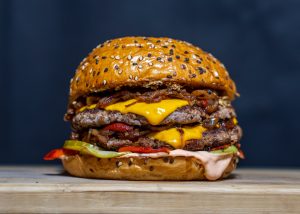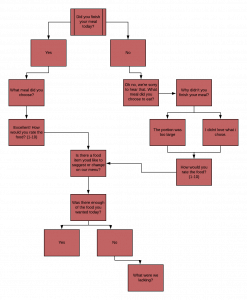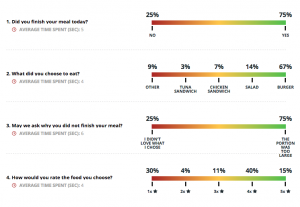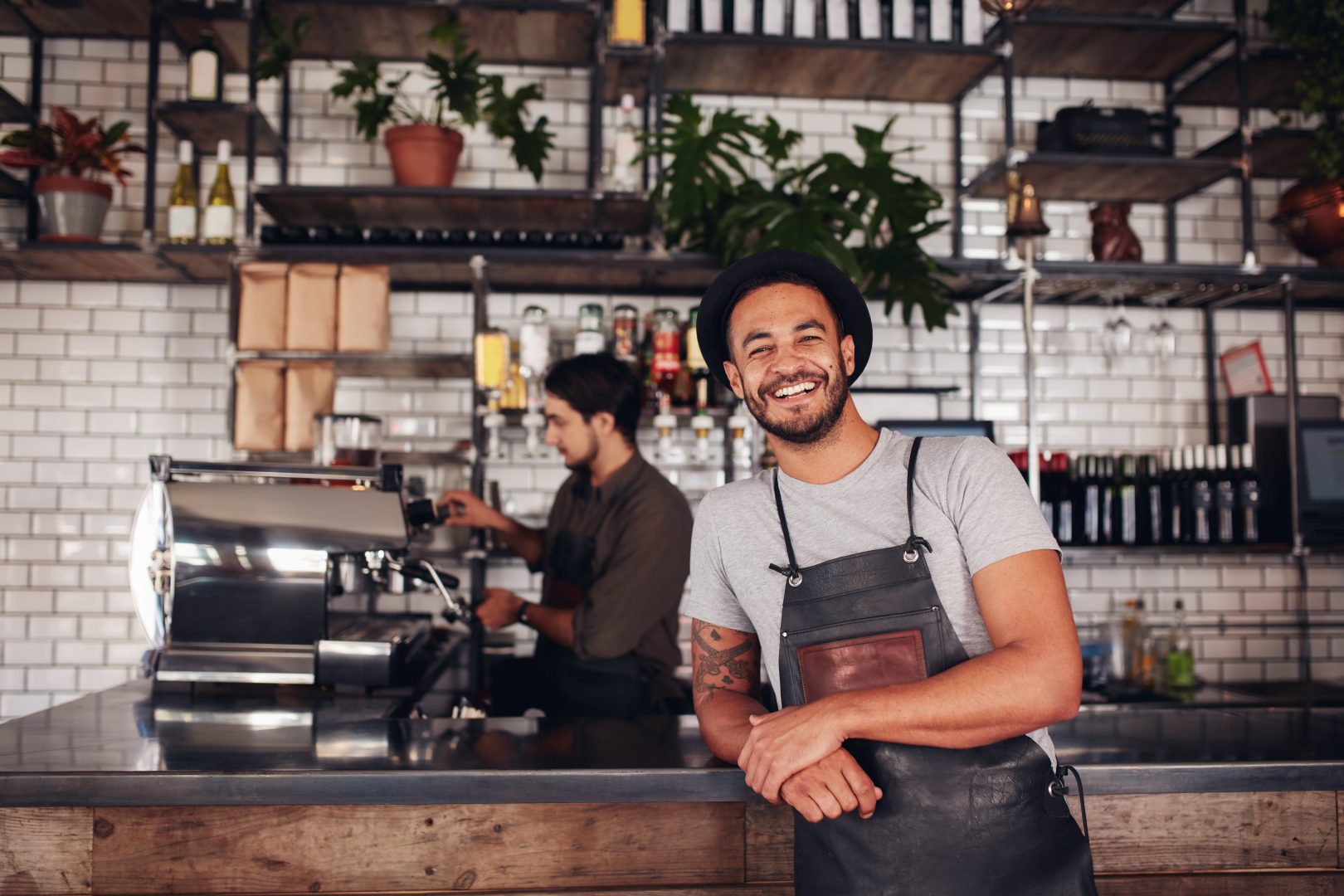I’d like to tell you a story about my friend Eric and how we used customer surveys to solve food waste in his cafeteria.
Eric is the Chef Communar for a large office building in the Lehigh Valley. His cafeteria serves over 550 employees with breakfast and lunch throughout the week. One of his responsibilities is to order the food and kitchen supplies; another is to build the menu for the week’s meals.
Most days, he serves a basic continental style breakfast with a waffle station, but his lunches are where he flourishes. Eric offers a variety of different dishes for lunch. On any given day, employees can smell the aromas of lasagna, roast beef, or autumn squash soup wafting up from the kitchen.
While Eric loves his job and the people he serves, he’s noticing one major problem: the excessive amount of food diners throw out every day!
Eric is not alone in his struggles. Every day, Americans throw out approximately 150,000 TONS of food. Among the biggest contributors to daily food waste are restaurants and grocery stores.
Eric and I set out to find out why restaurants and high traffic cafeterias, such as his, throw away so much food.
Our theories circled around three of the five major food waste factors:
- Portion sizes being served are too large – people just aren’t finishing their food
- Over-ordering of products – too much food to use before it spoils
- Over-estimating sales of prepared foods – making more than people order
- Not enough menu choices
- Quality of food
We wanted to look to Eric’s customers for answers to why they aren’t finishing their meals. The two of us were curious if it was just portion size issues, or if there was a behavioral aspect to their waste. To get our answers, we should have to conduct some customer surveys.
Portion Sizes
It doesn’t come as a surprise that Americans have increased their portion sizes. Researchers at the University of North Carolina at Chapel Hill listed out common foods and how their portion sizes have increased over the years.
- Hamburgers have expanded by 23 percent
- A plate of Mexican food is 27 percent bigger
- Soft drinks have increased in size by 52 percent
- Snacks, like potato chips, pretzels or crackers, are 60 percent larger

I asked Eric why he served such large portions in his cafeteria. He talked about “value sizing”. It’s how his customers can better rationalize the prices he charges in relation to the food they buy. They think they’re getting a good deal; larger portions for less money.
While the dollar value might be there, his customers are still throwing away a decent amount of their food, resulting in waste.
If Eric cut down his portions for the same price, would he see less waste without affecting his bottom line? Would customers even notice a smaller portion?
We started to ponder these questions as we moved along in our research.
Over-Ordering Ingredients
The second factor to Eric’s food waste problem was over-ordering food. Eric orders his food bi-weekly to keep things as fresh as he can. His deliveries come on different days, so he plans his menu accordingly. However, to save money, he orders bulk items he doesn’t always use.
This is actually a common trend with most shoppers in America. We have bulk stores like Costo and BJ’s that offer great prices, but you have to buy more food than what you really need. I know I’ve fallen victim to this: there’s a sale on cucumbers, one for $0.99 or 3 for $1.50 – it’s a no brainer! I always buy three even though, in reality, I’ll eat one, maybe two. The third normally ends up in the trash or my compost pile.
Eric admitted that his inventory system could use a bit more upkeep. Fixing this would contribute to ordering and wasting less food.
We also started to wonder if there was a way we could ask diners what foods they’d be more likely to eat. Was Eric making too much of an unpopular dish? Or was he not making enough popular dishes, forcing people to choose a less favorable option.
Over-Estimating Sales
Some weeks, Eric said, he would get so excited about a new recipe that he would make it in excess. His anticipation for sales with this was usually wrong. Nothing against Eric’s cooking, but he acknowledged that some of his diners were very routine – ordering the same foods every day.
It occurred to Eric, he would rather run out of food than have to throw away a full pan because it wasn’t eaten.
Eric started to wonder, could we survey diners about next week’s menu beforehand? Could he ask his diners what they’d actually like to eat? If he offered more food they wanted and less food they didn’t like, maybe they would waste less.
This solution would allow him to make the appropriate amount of several dishes. He’d been able to offer a variety while still feeding cravings (pun intended?).
Why Do We Waste So Much Food
Eric and I started to think about why we are so ok with tossing away food. Why don’t diners make a more conscious effort to only take what they’ll eat? Does everyone have a case of eyes that are bigger than his or her stomachs?
via GIPHY
We started to do research into the behavior behind food waste and to our surprise, a lot of the topics surrounded childhood food waste. There’s research from Dr. David R. Just, co-director of the Cornell Center for Behavioral Economics in Child Nutrition Programs that supported our idea of offering better choices to help reduce waste.
Dr. Just’s research revealed that children who were able to choose what goes on their plates were more likely to actually eat it, as opposed to being served carrots or broccoli they’re just going to refuse to eat, thus they go to waste.
We wanted to know if the same concept would be true in adults. If Eric allowed his diners to choose what foods he made for lunch, maybe there would be less waste!
I was able to connect further with Dr. Just on this topic. We wanted to know if adults (as diners) had more input at restaurants or cafeterias about portion sizes or food offerings, there would be a correlation to less food waste?
Dr. Just agreed that “when adults can choose what is on their plate they are less likely to leave food on the plate. Also, perhaps a bigger concern for adults, when they are able to choose the amount of food prior to ordering, they are less likely to throw food away.”
Eric and I had an answer!
Customer Survey – Let’s Ask The Diners!
We decided the best way to figure out why diners threw away so much food was to ask them.
Eric set up a customer survey kiosk in his cafeteria that asked his customers the following questions on their way out:

With this customer survey, Eric and I hope to gain a better understanding of the preferences of his diners. We will be able to draw clear conclusions from the analytical data we collect.
Stay tuned for an update on our findings!
UPDATE!
After a few weeks of collecting customer feedback, Eric was able to gather the following results:

His survey showed that most of his customers finish their food. Those who do not, report portion sizes being too big.
Eric also decided to switch up some of his recipes after seeing some poor customer feedback about his dishes.
After making these changes and reducing portion sizes, Eric told us that his customers are much happier with the meals they’re purchasing and he is seeing significantly less food waste in his cafeteria!

